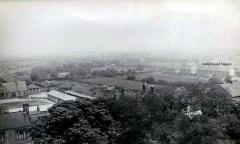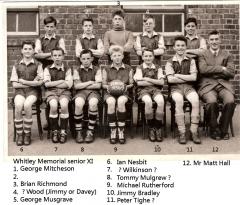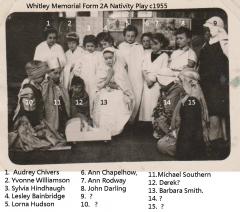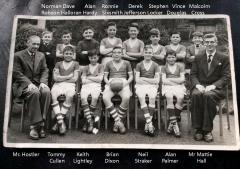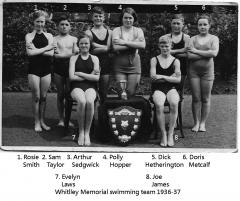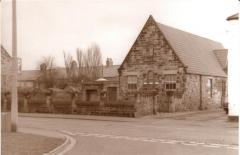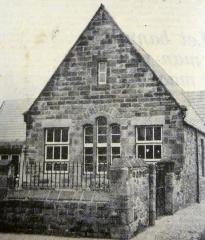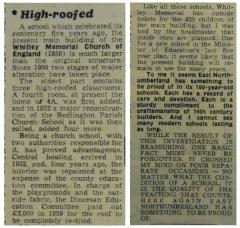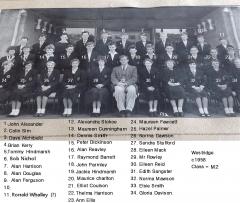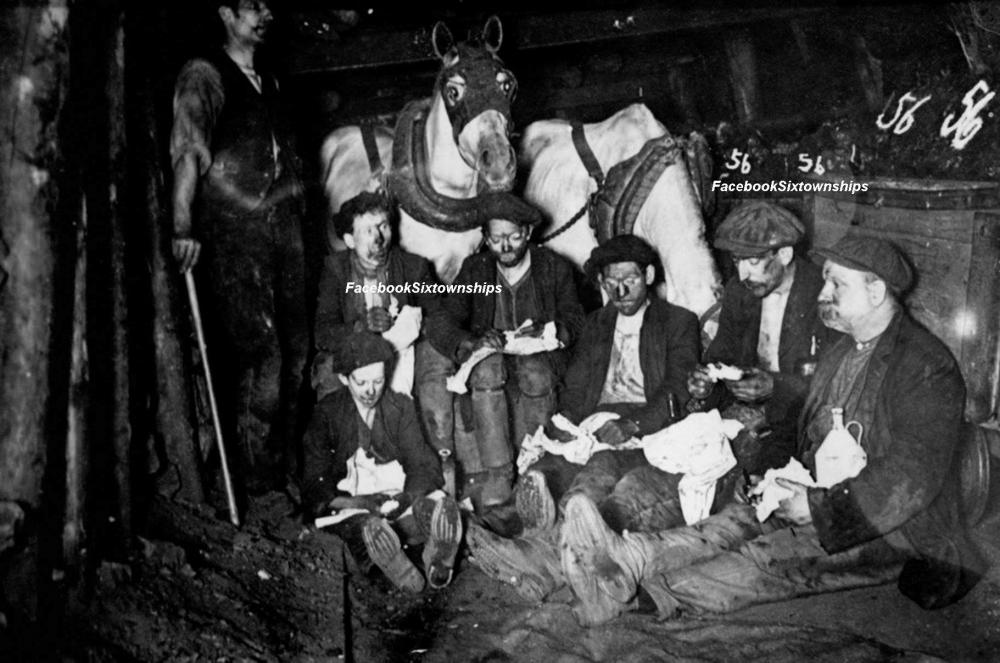
Alan Edgar (Eggy1948)
Supporting Members-
Posts
6,835 -
Joined
-
Last visited
-
Days Won
343
Content Type
Forums
Gallery
Events
Shop
News
Audio Archive
Timeline
Everything posted by Alan Edgar (Eggy1948)
-
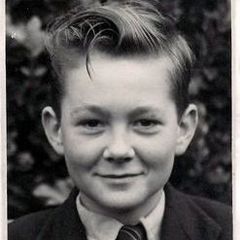
Whitleyley Memorial School - date not known
Alan Edgar (Eggy1948) posted a gallery image in Historic Bedlington
From the album: Whitley Memorial School
As the Hollymount Square houses, middle right on photo, look completely built the photo would probably be after 1948. -

Whitley Memorial 1952-3 Football team
Alan Edgar (Eggy1948) posted a gallery image in Historic Bedlington
From the album: Whitley Memorial School
Can't remember what site (searched 3 group sites) this photo was originally posted on so no idea who posted it and gave the names. -

579cc6ff9babe-Whitley-Memorial-1956-7Footballteamnamed.jpg
Alan Edgar (Eggy1948) posted a gallery image in Historic Bedlington
From the album: Whitley Memorial School
Posted on the Bedlington remembered group by Debbie Haldron. Photoshopped (not professional) by me. Names added by Joan Riches from the Bedlington remembered group site. -

Whitley Memorial 1967-8 Football team
Alan Edgar (Eggy1948) posted a gallery image in Historic Bedlington
From the album: Whitley Memorial School
Posted on the Bedlington Remembered group by Debbie Haldron. Photoshopped (not professional) by me. Names added by Susan Dixon off the Bygone Bedlington site. -

Form2A Whitley Memorial School Nativity Play c1955
Alan Edgar (Eggy1948) posted a gallery image in Historic Bedlington
From the album: Whitley Memorial School
Image from Maureen Quait - names from Maureen (nee Halloran) and Mike Irving off the Bygone Bedlington Facebook site. -

Whitley Memorial 1959-60 Football team
Alan Edgar (Eggy1948) posted a gallery image in Historic Bedlington
From the album: Whitley Memorial School
Posted on the Bygone Bedlington Facebook site by Keith Lightley. -

Whitley Memorial 1936-37 swimming team
Alan Edgar (Eggy1948) posted a gallery image in Historic Bedlington
From the album: Whitley Memorial School
Posted on the Bygone Bedlington Facebook site by Jack Kidd. -

Whitley Memorial school
Alan Edgar (Eggy1948) commented on Alan Edgar (Eggy1948)'s gallery image in Historic Bedlington
-

Whitley Memorial2.jpg
Alan Edgar (Eggy1948) commented on Alan Edgar (Eggy1948)'s gallery image in Historic Bedlington
-
From the album: Whitley Memorial School
Newspaper cutting found by John Krzyzanowsk in the Woodhorn Colliery museum archives and posted on the Bygone Bedlington Facebook group. -
From the album: Whitley Memorial School
-
From the album: Whitley Memorial School
-
From the album: Whitley Memorial School
-

Going places, meeting people
Alan Edgar (Eggy1948) replied to Canny lass's topic in Talk of the Town
Buttered sprouts with chestnuts and bacon - ---------------------------------------------------- 1¼kg Brussels sprouts, trimmed (or if buying pre-trimmed, buy 1 kg) 6 rashers smoked streaky bacon, cut into bite-sized pieces (or use more, if you like) 200g vacuum-packed chestnut 50g butter -------------------------------------------------- Take the sprouts out, leaving the crispy, crunchie bacon + nutty bits and your on. Otherwise I'll stick to peas and carrots. ------------------------------------------------ Some of the Daily Telegraph Brussels sprout facts The area covered by Brussels sprout fields in the UK is the equivalent of 3,240 football pitches Last year, a team of scientists and local schoolchildren used the energy from 1,000 Brussels sprouts to light a Christmas tree on London's Southbank. In 2010, the British vegetable brandTozerseeds created a new vegetable called the Flowersprout, a hybrid of the Brussels sprout and kale that contains double the amount of vitamin B6 and vitamin C of traditional Brussels sprouts. In August, adventurer Stuart Kettell, 49, rolled a Brussels sprout to the top of Mt. Snowdon using only his nose, to raise money for Macmillan Cancer support. Sprout fan Linus Urbanec from Sweden holds the current world record for the most Brussels sprouts eaten in one minute. He swallowed 31 on November 26, 2008. The heaviest ever sprout was grown in 1992 and weighed 8.3kg (18lb/3oz). -

Members unable to access forum.
Alan Edgar (Eggy1948) replied to Alan Edgar (Eggy1948)'s topic in Chat Central
-

Members unable to access forum.
Alan Edgar (Eggy1948) replied to Alan Edgar (Eggy1948)'s topic in Chat Central
Cheers Andy. I couldn't make up a plausible excuse for not seeing that link! Appointment booked with Specsavers. -
Admin - current member, Keith, has not visited the forum since last year and has forgotten his password. How does he regain access to the site?
-

Westridge c958 with names
Alan Edgar (Eggy1948) commented on Alan Edgar (Eggy1948)'s gallery image in Historic Bedlington
-

Going places, meeting people
Alan Edgar (Eggy1948) replied to Canny lass's topic in Talk of the Town
Please, please, please, CL negotiate a deal that prevents sprouts from being eaten anywhere except Brussels. Strike a bargain with Brussels - they can have the sole rights to sprouts; growing, boiling and eating, and Melton Mowbray can keep it's protected name for it's pies when we leave the EU. ( don't pull me up on this, I know the chairman of the Melton Mowbray Pork Pie Association Matthew O'Callaghan, who is also chairman of the UK Protected Food Names Association, said the protected status could be maintained). The European Union granted the Melton Mowbray Pork Pie protected status in 2008 which meant only pies made in the area could carry the label. This must also apply to Brussel's Sprouts Cutting an 'X' in the stem of a Brussels sprouts to aid cooking = Br-x-it. Is it only me that hates the taste, and the smell when cooking? If however the miners had of taken sprout sarnies down the pit then I am sure the smell of the sprout sarnies and the expulsion of the sprout gasses would have driven the 'shit-flies' out of the shaft and Symtoms wouldn't have his current project to prove how those flies survived the byeways of the pits. -
No scientific explanations offered on the existence of these flies. Looks like it could be down to HPW to see if he made notes and studies of the flies that lived off the gallawa droppings; miners droppings; cheese & jam sarnies and crawled up your nose for fun. Tried a Google of - 'pit men underground flies' - 'shit flies in coal mines' but for once nothing returned that resulted in a cry of eureka! Were flies tolerated so there was no need to bring canaries into the pit to prove one could breath, and smell, underground? Plenty water in the mines so no need for the intake of urinated refreshment. Symptoms - have you done some research?
-
So are you saying that everyone, apart from yourself, is either a) not allowed an opinion b ) not allowed free speech c) Labour party members who are parents must not say anything to our children, grandchildren etc. etc. in case they turn out to be political activists e) only Labour indoctrinates children f) me mam wasn't entitled to a point of view and g)g)g) the only time a man and woman can have simultaneous orgasms is when the judge signs the divorce papers (pinched from Woody Allen). And this guy, me, fit or not, wont be making any further replies on this topic.
-
Apart from a short guided tour, early 60s, a short distance into the Dr. Pit, probably with a chocolate bar in me pocket, never ate underground but always found the stories and the reasoning behind sarnie fillings interesting and amusing. Extracts from some of the members comments on the sixtownships site :- Mick Riley :- Used eat mine on the kist next to a transformer - Geoff Glass :- Used to sometimes eat mine sitting on transformer Nancy Luke :- Dad always had his jam sandwiches ,cheese attracted the rats lol.x Bill Engles :- My Dad (Joe Engles, Ellington) always took something for his Gallower too. Margaret Vare :- they had bread n jam .......they say it was the only thing that had any taste down the pit .... Pam Farquhar :- My grandad Tyler used to take an extra jam sandwich doon the pit and bring it back for me mam when she was a little girl she said it tasted lovely x Doreen Armstrong :- My dad used to take sugar on bread when he worked down the pit (for a short time in his life) because he said everything tasted the same down there!. Lawrence Whitfield :- I've had my bait in worse places than that so have most miners.The paper wrapping the sandwiches would be used to hold the bread as you ate it,you never knew where those hands had been!, It was a flask of tea I'm my day but that had its hazards,uncovered the top would get covered in coal dust or even worse,shit fleas.I didn't mind swallowing the dust but I drew the line at the fleas. John Dawson :- Lawrence if i had no paper held me sarnie on the corner and threw the corner bit away on the belt. Seen some throw food on the ground and you know they generated the deadly and termed "Shit Fly" Had to sit with my lamp out as if it was on it attracted them to you. Mind you must have swallowed many accidentally too. Lawrence Whitfield :- As long as we didn't know it was ok,it was awful if one of the little buggers got up your nose though a good pinch of Singletons snuff helped get it down again.Once the snuff got dried up in your locker it would blow a safe door off. Lawrence Whitfield :- One bloke down Lynemouth never carried bait or water,he would sneak a drink out of someone else's bottle as it hung on a dog in a prop.In the end the blokes got fed up & laced the water with Epsom Salts,they reckon the result was spectacular.. Rob Hardy :- Had to sit in tub sometimes to have bate cos it was too wet to sit Malcolm Common :- I remember at Burradon as you got out of the cage at the Bensham Seam Inset somebody had chalked on one of the Girders " Your'e late Your'e Late your much too late Geordie Johnson's snatched your bait " also when walking into a flat you would see the little bait parcels wrapped up and hung up from the centre of the arch girders with cap wire in an attempt to to prevent mice getting into jacket pockets and eating your bait while you were on the face. ------------------------------------------------------------------ and I'm sure HPW will explain any pit terminology, like Kist - A chest or the Deputies' office underground often used as an assembly point for men to find out where they will be working ?
-
Normal service resumed. Thank you.
-

Self balancing scooter
Alan Edgar (Eggy1948) replied to Alan Edgar (Eggy1948)'s topic in Chat Central
And here was me thinking you might have swapped your bike for one! -

Self balancing scooter
Alan Edgar (Eggy1948) replied to Alan Edgar (Eggy1948)'s topic in Chat Central
Does this mean you have/had one Chris?

